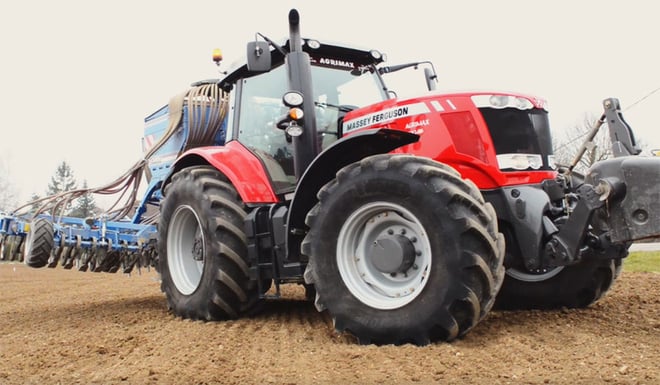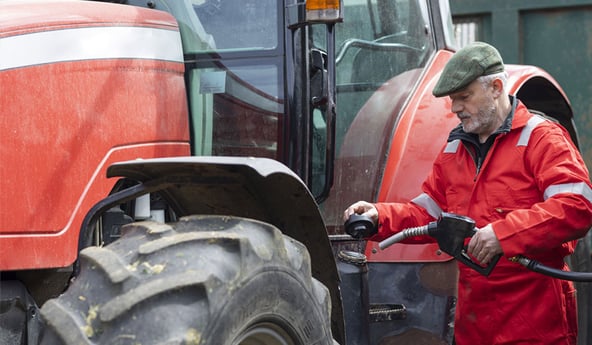Not all your engine power is directed into carrying out your work. Part of this power is used to operate your tractor and another part is lost due to incorrect settings or failure to optimise your equipment. The power dedicated to traction varies from 30 to 62% depending on your choices, your settings, your equipment or your implements.
You can easily boost the productivity of your tractor and double the amount of power transmitted to the ground.
This article introduces the different optimisation points that you easily develop when replacing your tyres, simply by choosing a model that is perfectly adapted to the work you do, with better traction capacity and less slip.
You have chosen to invest in a powerful machine and you have the opportunity to get more from its power, to boost productivity and improve your yields.
1. How is the engine power used?
Traction power is the force available at the coupling hook to draw your implements.
Unfortunately, you cannot use 100% of the engine power for this tractive effort because part is used for the mechanical operation of your tractor. However, you do have the possibility of increasing the power available for your work, by making use of different adjustments, with the tyres certainly the part that is easiest to adapt.
The mechanical elements that use up part of the power correspond to the hydraulic, cooling or exhaust systems… another part is used by the drive shaft which transmits engine power to the tyre rim with a loss of efficiency of around 5 to 10% on average. These mechanical losses are inevitable and there is little possibility of optimisation at this level.
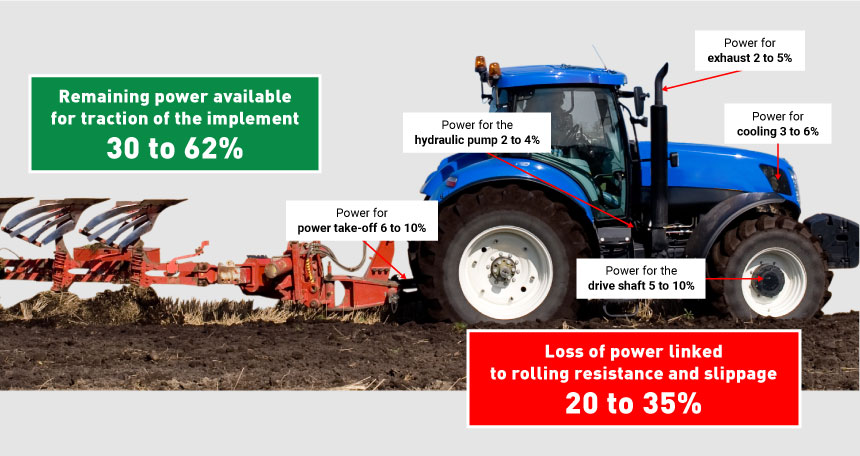 Breakdown of the use of engine power
Breakdown of the use of engine power
However, there is some room for manoeuvre in relation to the main loss of power at the level of the tyres, where there are 2 types of loss of power:
1. Rolling resistance
Elle peut atteindre 25%, c'est quand le pneu s’enfonce dans le sol meuble, en fonction de plusieurs paramètres :
- the weight on the axle,
- the inflation pressure,
- the width of the tyre,
- its technology,
- its structure.
The more the tyre sinks into the ground, the higher the rolling resistance and the more power required to draw the trailer.
2. Slip
Loss of power linked to the tyres slipping on the ground can reach up to 30%, or more. Slippage is obviously linked to weather conditions, but also to various specific tyre parameters:
- their technology,
- their design,
- the pressure at which they are used.
The objective is not to eliminate slip, which is necessary, but to control it perfectly to ensure optimal transmission of traction.
2. More traction with the right tyre dimension
The first point to bear in mind is that the transmission of power to the ground increases with the size of the contact patch between tyre and ground. The larger the contact patch with the ground, the more lugs there are to grasp hold of the ground, which improves traction mechanically.
When you buy your tractor, the tyres supplied are an average choice, allowing the manufacturer to limit the overall acquisition budget, but they are generally not the most suitable tyre solution for your farm.
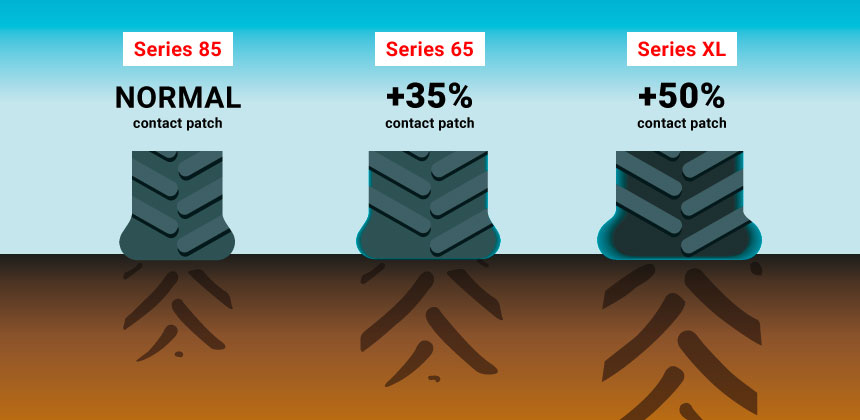 Changing tyre size allows you to increase the contact patch with the ground
Changing tyre size allows you to increase the contact patch with the ground
3. The tyre design is crucial to its efficacity
Not all the tyres available on the market have benefitted from the same level of research and development and often certain details, which may seem insignificant, have a real importance in actual operating conditions over several hectares.
The involute lug
LOne of the main transmitters of engine power to the ground are the tyre lugs. The leading edge of the lug digs into the ground, then takes a hold on the earth to transmit torque.
The lugs generate a horizontal compression which transmits tractive force to the ground. When they disengage, classical lugs create a soil displacement effect by lifting the earth and reducing the tyre’s self-cleaning capacity.
Bridgestone’s Involute lug design has been optimised to avoid this soil displacement effect thanks to a specific lug construction which increases the transmission of horizontal force. Their very particular profile angle allows excellent self-cleaning of the surface of the tyre before it comes into contact with the ground again.
Video explaining the role of involute lugs in providing improved traction
4. Management of pressure to maximise traction
Pressure adjustments have a direct impact on your tractor’s traction capacity. By working at low pressure, you increase the size of the soil footprint and, just like with a change in tyre size, your lugs will have a better hold on the ground. Adjusting inflation pressure allows you to avoid working with overinflated tyres, which can generate slippage rates of up to 30%, which also has an impact on fuel consumption, tyre wear and working time.
Testing in real conditions
In the example below, we carried out tests in a field, varying the inflation pressure on the same tractor, on the same plot of land, in the same weather conditions. The difference is clearly visible:
- On the left: with inflation pressure at 1 bar, self-cleaning was correct and traction efficient despite the wet conditions.
- On the right: with inflation pressure at 1.25 bar, there was immediate slippage.
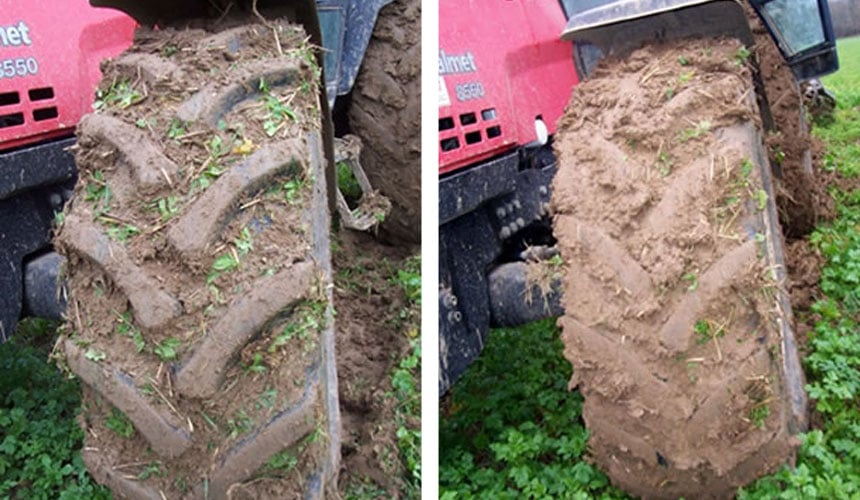 Slippage linked solely to a change in tyre pressure
Slippage linked solely to a change in tyre pressure
5. The use of VF tyres to be sure of obtaining improved traction
There is an enormous difference in productivity between 30% transmission of tractive force and optimal traction of 62%.
Can you imagine what that represents in working time and in fuel in the space of one day? one month? or a full year?
VF technology for work at very low pressure
Taking into consideration each of the points mentioned above, you can further optimise traction capacity by choosing the best that technology has to offer. VF tyres such as the VT-TRACTOR allow you to work at an inflation pressure of as low as 0.6 bar while increasing your load.
This type of tyre is the perfect solution if you wish to avoid duals and all the related disadvantages while retaining all the benefits.
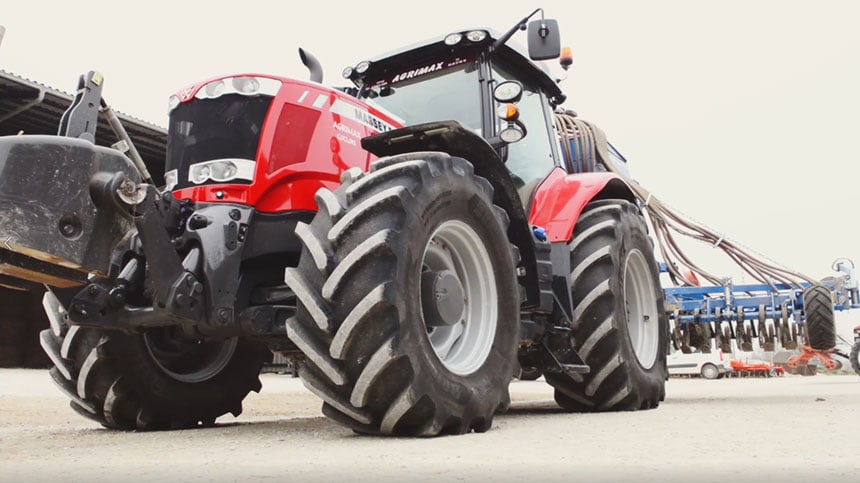 VF technology allows you to work at an inflation pressure of 0.6 bar
VF technology allows you to work at an inflation pressure of 0.6 bar
Saving time on pressure adjustments
The reinforced casing structure and exceptional sidewall design of these tyres makes it possible, without any problem, to drive on the road with the same inflation pressure as used in the fields. These improved flexion tyres mean that you no longer have to waste time adjusting your inflation pressure each time you change operating area (field/road, road/field.
The Bridgestone-agriculture.eu blog is written and administered by tractor tyre experts who are available to provide you with the advice you need on the subject of your agricultural tyres. They allow you to maximise your productivity with information on all subjects linked to tyres: Cheap tractor tyres — Technical data for agricultural tyres — Air pressure advice — Solutions to avoid soil compaction — Sprayer tyre pressure — Why and how to ballast your tractor tyres — When to use dual wheels — The mechanical causes of abnormal wear — Cheap agricultural tyres – etc…
To learn more and boost your farm's profits, Bridgestone-Agriculture is offering you a free, detailed white paper that explains the essential role your agricultural tyres play in your productivity.
Most people who read this article have also read some of the following articles:
- 5 essential techniques to optimise your agricultural tyres
- How your agricultural tyre footprint can help you detect a problem
- Manage your pressure to the ground to make your agricultural tyres last longer
- Dual mounting the best solution for optimal productivity
- Which agricultural tyres improve the tractive force of your tractor?
- Tractor tyres are crucial for successful ploughing
- How best to use your tractor tyres: wide or dual tyres
- Use forestry tyres for more resistence and motricity
- How your agricultural tyre footprint can help you detect a problem
- How to adjust wheel alignment and avoid wearing out my tractor tyres
- How your tractor tyres affect your fuel expenses
- Why your tyres’ speed index is primordial
This information is intended only to make you aware of the technical and functional aspects of agricultural tires and their use. It does not allow you to make a judgment or a definitive conclusion on a given problem. Only your agricultural tire expert is able to make a technical assessment and take a final decision, case by case.
Leave a
commentary
Your email address will not be published.
Required fields are indicated with *


